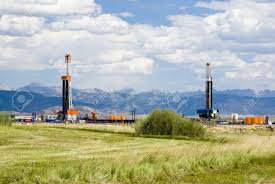
The actions of dozens of Oklahoma oil and gas companies is leading analysts to predict the state of Wyoming could lose $555 million to nearly $2.8 billion in state revenues over the next two years. That’s how many Oklahoma exploration and production companies from Oklahoma City and Tulsa and other cities are active in Wyoming’s oil and gas fields.
What actions they take will directly affect Wyoming’s state government as a result of the oil price crash and the COVID-19 pandemic.
Consider this: Chesapeake Operating LLC of Oklahoma City and Devon Energy Production Company L.P. are among the state’s top producers. They are among 21 Oklahoma oil and gas producers with interests and activities in Wyoming, many in the state’s Powder River Basin but others in some of the other basins including the Denver, Laramie, Hannah, Wind River, Greater Green River and the Big Horn Basins.
Oklahoma City firms with operations in Wyoming include: Chaparral Energy of Oklahoma City, Conoco, Crawley Petroleum Corp., Energas Corp., Gulf Exploration LLC, Huntington Energy LLC, Marathon Oil Company, Pioneer Natural Resources Inc. and Slawson Exploration Co. Inc.
Others include The Daube Company of Ardmore and Westar Oil and Gas of Edmond and many from Tulsa including Grayhorse Operating Inc., Kaiser-Francis Oil Company, Mid-Con Energy Operating Inc., Rki Exploration and Production Inc.,Samson Resources Co. Samson Exploration LLC, Unit Petroleum, and Zenergy Inc.
Whatever happens to the Oklahoma energy producers in Wyoming has a ripple effect on Wyoming’s state coffers and legislators received the warning from their Legislative Service Office.

Though what will unfold in the coming months remains anyone’s guess, the revenue decline could be so dire that, as one lawmaker put it, it would require the most “painful change the state has had to ever deal with,” according to a report by WyoFile.
LSO fiscal analysts drew up revenue predictions for three scenarios — optimistic, intermediate and pessimistic. They looked at impacts across sales and use taxes, oil, gas and coal severance taxes and only some of the state’s investments — leading some lawmakers to predict the realities could be even worse in a time of stock market turmoil.
The analysts urged lawmakers to view the estimates as “informed guesses,” given deep uncertainty about what the future holds. Still, even the best-case estimate is staggering.
For the optimistic scenario of “a shorter economic downturn and a quicker recovery,” according to the memo, analysts predicted a loss of $555.8 million in revenue.
An intermediate scenario assumes “continued economic disruption throughout the summer and a modest recovery over the next year,” with a slower recovery rate than the optimistic scenario. The intermediate scenario anticipates a $1.76 billion hit.
The intermediate scenario “is not necessarily the expected scenario,” the analysts wrote in the memo. “Nonetheless, it does use the timeliest information, e.g., current futures prices of major commodities.”
A pessimistic scenario “incorporates a drawn out crisis with an extended recovery,” the memo said, “for example, a second wave of the virus, potentially next fall, and a much slower recovery compared to the other scenarios.”
Under that outcome, the state could lose nearly $2.8 billion in revenues. That number is comparable to the entirety of the general government spending budget for the next two years.
The budget lawmakers passed in March spends $2.9 billion of state funds on general government and $2 billion on public schools in fiscal years 2021 and 2022. It allots billions more in federal funding and other dollars. All told the budget prescribes more than $7 billion in spending for the next two years.
The Legislature has nearly $1.4 billion in its most accessible savings account, nicknamed the rainy day fund.
The April 10 memo from the analysts to the entire Legislature was obtained by WyoFile and has not been made public until now.
The memo’s predictions come with considerable caveats, written at a time when people the world over begin each week unsure what the pandemic will bring.
The memo is an LSO product, and was not crafted through the same process that sets the official revenue estimates used in budgeting. The Wyoming Legislature writes the state’s budget using projections of the revenues that will come in over the two-year budget period. Those projections are crafted by a group of fiscal analysts and economists from across state government called the Consensus Revenue Estimating Group, or CREG.
The CREG did now draw up the memo to lawmakers, though CREG members offered input and Don Richards, a co-chairman of the group and the LSO’s top fiscal analyst, was one of its authors. CREG’s predictions are far more precise than the wide ranges included in the memo.
Nationally it remains unclear when COVID-19’s spread will slow, allowing officials to lift the preventative measures to keep people apart — measures that have resulted in a near shutdown of the economy. Much also remains unknown about the virus itself, the potential development of vaccines, improved testing and many other factors that will shape the broader picture.
The federal government has already passed a bill pumping $2 trillion in aid into the country, and more stimulus actions are appearing on the horizon. The economic impacts of such legislation, including the potential to “over-stimulate” some sectors and drive up inflation, is unknown, the memo notes.
“Given the lack of precedent, lack of reliable internal and external modelling [sic], and the diversity of both Wyoming anecdotal information and national forecasts – many of which have been regularly revised over the past month – the confidence one should place on these scenarios is limited,” the memo reads.
In a stark description of the widespread uncertainty, the memo includes this caveat: “It is also possible that the world economy could deteriorate throughout the entire next [two-year period] without a meaningful recovery.”
Source: WyoFile




